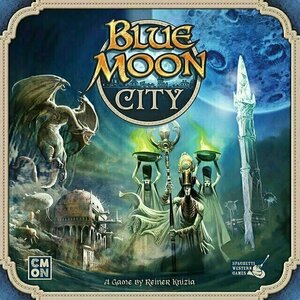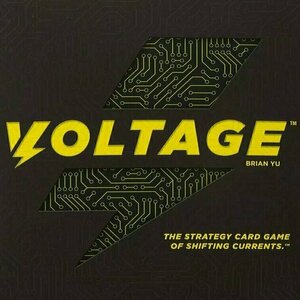
A Fashionably French Murder
Book
American expat Tabitha Knight has found a new life in postwar Paris, along with a delightful friend...

Reeds Point
Book
Reed’s Point starts with Mark Reed sitting on the bench made by his ancestors. He looks over the...
Young Adult Romance Fiction
Purple Phoenix Games (2266 KP) rated Blue Moon City in Tabletop Games
Aug 27, 2021
Blue Moon City is a fantasy-set, hand management, set collection, city rebuilding game for two to four players. In it players are attempting to help reconstruct the war-ravaged Blue Moon City to its former glory by utilizing its citizens at crucial construction sites in order to earn crystals. It sounds weird, and it is, but read further to understand why. Oh and there are dragons that act like supervisors or teachers when they come stand by you to watch you take a test and judge you from behind the whole time.
To setup, place the Courtyard tile in the middle of the table and build the city in a 5×5 grid minus the corner tiles. Each player chooses their color and takes the mini and discs of that color. Place the dragons nearby, along with the Obelisk token, draw deck of cards, crystal chits, and dragon scale chits. Deal each player a hand of eight cards and the game may begin!
Blue Moon City is played over a series of turns, and each turn is divided into four phases: Movement, Contribution, Reset, Pass Turn. During the optional Movement phase, a player may move their pawn one to two orthagonal spaces (N/E/S/W) or use cards from their hand for their special movement powers for player pawn AND/OR dragon movement.
Next, a player may discard cards from their hand to contribute to the reconstruction of a building during this optional Contribution phase. By discarding a number of cards whose values equal or exceed the printed value on the matching-colored building tile a player will be able to place a disc upon the tile. Once the tile’s contribution spaces have been filled with discs it can be scored. To score a building tile, determine majority presence on the tile and award the Majority Bonus to that player. Any disc presence in minority will receive the Construction Bonus, including the majority winner. If a player had contributed on a tile that also was hosting a dragon mini, that player would earn a dragon scale from said dragon supervisor. Players may also make their way back to the Courtyard tile in order to donate crystals to the Obelisk. Doing so will allow the player to place one of their discs on the Obelisk itself, and the game ends when a player has placed the proper number of discs upon the Obelisk per the number of players.
When the pile of dragon scale tokens has been exhausted, players will check who currently holds the majority of scales. They will be awarded with six crystals, and any player holding three or more will receive three crystals. Turn all the dragon scales back into the supply to be earned again.
During the Reset phase a player may discard any number of cards from their hand and draw back as many cards plus two. So if a player discards zero cards from hand they would still draw two from the deck. Discarded four cards? Well redraw six.
Finally the active player will Pass Turn to the player on their left, who will complete their turn of the same four phases.
Play continues in this fashion until one player has placed the target number of discs on the Obelisk token to claim victory and dragon approval!
Components. Okay, this is a tough one because overall I love the components in the game. The dragons and player pawns are cool minis (from CMON that just makes sense). The Obelisk token is huge and I love how it looks. The art overall is really creepy, but well done, and enjoyable to behold. The player discs, though poo-pooed by other more-renowned reviewers, I find to be just fine. They are a smooth plastic in the player color and I have no problems with their quality. But speaking of colors… I agree with others that have stated the colors of some cards (or suits, if you prefer) should have been made a different color. What I mean is that the game is very greige-heavy throughout. The card suits (except the red, yellow, and blue) are a variation of the same greige that makes eyes strain to determine exactly which color they are holding. I understand that a certain aesthetic was targeted, and they certainly achieved that, but these colors do make it more difficult to play, especially for us that are starting to over-ripen with age.
Those component gripes aside, this is an incredible game. The color choices aside, I love everything about it! The movement from tile to tile, and trying to align movement with the cards in hand and keeping some back so that you can use them to move the dragon to your spot as well is just fun mental exercise. Each value 1 and 2 card has a special ability, be it movement bonuses, changing other cards’ colors, or just being straight up wild cards, and having to choose to use the cards as either the special power or for contribution values creates tons of crunchy gamer choices. Not super-crunchy. Turns won’t be mentally debated for 10 minutes, but deciding how best to use the hand of cards you hold is great.
I also very much enjoy the theme of the game, even though I was hoodwinked by the title (not really, just trying to tie it all back). I love fantasy worlds and having a unique theme is a definite plus for me. I haven’t yet thrown in the expansion tiles, but I will the next time I play. If you need a relatively quick-playing jaunt through a ravaged city, I recommend you check out Blue Moon City. Purple Phoenix Games give it a 10 / 12. It has nothing to do with beer, which would be another great theme idea – drunken dragons – but I will be holding onto this one for quite a while.
Purple Phoenix Games (2266 KP) rated Voltage in Tabletop Games
Jan 8, 2022
Voltage is a competitive game for 2 players in which players are trying to be the first to earn 4 total points. To setup for the game, place the board between the two players. Take the double-sized Terminal blocks and place them on their corresponding spaces of the board. The starting orientation for the Terminal blocks should read + – – + horizontally across the board. Shuffle the deck of cards and deal 4 to each player. Each player selects a Score Marker and places it on the first space of their score track. Choose a starting player, and the game is ready to begin! Pictured below is the starting setup for a game.
Over a series of turns, players will be playing cards to their corresponding colored Terminals in an attempt to win the set. If the Terminal is set to a + then the player with the highest value will win the set. Alternately, if the Terminal is set to a – then the player with the lowest value will win the set. Cards are played to Terminals until a Terminal has a set of 5 total cards. The Terminal is then scored, the cards used are discarded, and the winning player earns a point. The game continues in this fashion until one player has earned 4 total points.
On your turn, you must perform one of these three actions: Play a card & draw a card, Play 2 cards, or Draw 2 cards. Simple enough, but the strategy is what makes this game. When playing cards to the different Terminals, there are a few placement rules to keep in mind. Of course, you may only play cards to the Terminal of the matching color. You are allowed to play cards on your side of the Terminal, or on your opponent’s side. Now to get to the actions themselves. If you choose to play a card and draw a card, you must do so in that order. If you choose to play 2 cards, you must play both cards on different colors – you cannot play both to the same Terminal. The last action, draw 2 cards, is self-explanatory.
The cards of the game are numbered from 1-3, and are of the 4 Terminal colors. There are 3 types of special cards: Bypass, Blown Fuse, and Transformer. A Bypass card allows you to move a card from your opponent’s side to your side of the Terminal, and a Blown Fuse allows you to remove a card from your opponent’s side completely from play. Both of these types of cards count toward the 5-card maximum of the Terminals, so use them wisely. A Transformer is identified by the card back – if the V logo is colored Yellow. When you draw a Transformer, you must then flip one of the Terminal blocks to its opposite side. Since the draw deck is always visible, you can see when a Transformer card is next, so that could help inform your strategy for your turn. The game continues in this fashion of alternating player turns until one player has earned 4 total points. They are declared the winner!
I have to say that the gameplay of Voltage really surprised me. I went into my first play expecting a light little game, and what I got was so much more. There really is a pretty decent strategic element to this game that caught me a little off guard at first. The gameplay itself seems simple – draw cards, play cards, win sets to earn points. But how you accomplish that is more challenging that it seems. The ability to play cards to your side or your opponent’s allows you to try to tip the scales in your favor. You can’t simply focus on your side alone, you need to keep tabs across the entire board to inform your next move. And then if your opponent draws a Transformer, they could just as easily reverse the polarity of that Terminal and now you’re on the wrong end! When playing 2 cards, they must be played to different colored Terminals, so how can you place your cards so they are most beneficial to you? Do you risk placing the big numbers right away in hopes of winning a + Terminal, or do you play lower-numbered cards in case that Terminal gets flipped? All things to consider throughout the game. Along with the strategy, one thing that I love about Voltage is that there really is no runaway winner each time – the direction of a set can literally change with one card, and neither player can really feel secure during the game. You have to anticipate your opponent’s moves while trying to complete sets that are currently favorable to you. That all being said, I guess there is a bit of a ‘take that’ element in the gameplay that might seem a little aggressive to some players, but that’s kind of just the nature of this head-to-head gameplay.
To touch on components, this game is pretty basic. The cards are nice quality, and the artwork is electrical and thematic. The board itself is nice and thick, and the spaces are all clearly marked. The Terminal blocks are probably my favorite components of this game. They are nice chunky plastic blocks, and the colors are bright neon colors – some of my favorites! For a game with such few components, the quality of them is appreciated.
After playing Voltage with Travis at The Table, I actually came home and found a copy for myself – that’s how much I liked it! I don’t think it’s my all-time favorite 2-player game yet, but it’s certainly working its way up the list…. If you’re in the market for a fast, yet strategic, 2-player game, I would highly recommend giving Voltage a try. The simplicity of the gameplay coupled with the vast strategic options makes for an engaging and entertaining game. Purple Phoenix Games gives this one an electrifying 9 / 12.
Purple Phoenix Games (2266 KP) rated Hierarchy in Tabletop Games
Oct 1, 2019
Hierarchy is an abstract strategy game of perfect information for 2 players. Comprised of a mere 14 playing cards (excluding title and reference cards) it is quite the compact game – as is to be expected from the Button Shy crew. In a game of Hierarchy, players take turns playing cards from their open hand (no hidden information here!) on top of the last card played by their opponent, per the placement restrictions. To win, you must be able to play a card on top of which your opponent is unable to play a card – effectively ‘checkmating’ them and claiming victory for yourself!
DISCLAIMER: We were provided a prototype copy of this game for the purposes of this review. As this is a preview copy of the game, I do not know if the final rules or components will be similar or different to what we were provided. -T
Here’s how it works in detail. Each player first receives a Quick Reference Card, and is then dealt half of the deck (7 cards). The cards are double-sided to represent the two player colors – purple and gold – so each player flips their 7 cards to show their chosen color. Since this is a game of perfect information, all cards are laid out on the table, so each player always knows what cards their opponent has available to them. The player who was dealt the ‘Imposter’ card goes first. Each card has a specific number, ranging from 1 to 13, as well as a specific ability. To play a card, its number must be higher than that of the card below it, unless the card’s specific ability says it can be played otherwise. For example, if I play the Queen (#12), Travis could play the King (#13, numerically higher) or the Assassin (#1) since its power allows it to be played atop any card except for the Tower and Leper. Don’t be worried about having to memorize all the card abilities – they are all detailed on the Quick Reference Cards (see photo below). Play continues back and forth until one player is unable to play a card, either because they have no cards left at all or because they have no valid cards left to play. That player loses the game, and the remaining player is the top of the Hierarchy! (Roll credits)
Let’s talk components first. They’re excellent, which is no surprise coming from ButtonShy. Of course, we just have a preview copy of the game, so I can only imagine that the card quality might be up for improvement during the Kickstarter. That being said, the cards we received are nice and sturdy, as is the tell-tale wallet of a ButtonShy game. The text on the cards is a good size, and the font is easy to read. The artwork is fine, but quite honestly not something I looked at in depth until Travis mentioned the style. I think that’s because the cards are all monochrome, the art just didn’t really draw my eye. Not a knock on the game, just something I noticed! Speaking of color, I personally love the player color choices of Purple and Gold – the school colors of my Alma Mater ((the University of Northern Iowa, go Panthers!)(also of the Alma Mater of the rest of us – Western Illinois University – GO NECKS! -T)). Maybe I’m biased, but I think those two colors are a great combination 🙂
And how about the gameplay? I think it’s excellent. For such a compact and ‘light’ game, the strategy required for success keeps the game extremely engaging. You always know the cards your opponent has, and you’ve got to be thinking at least several turns in advance to try to back them into a corner while not letting yourself fall victim to an unnoticed strategic play. Another neat thing about Hierarchy is how quickly it plays – typically in 20 minutes or less. You might have to devote a decent amount of brainpower to outwitting your opponent, but you definitely don’t need to devote hours of time during your game night for this game, and I love that. Gamers who enjoy games like Citadels or Love Letter might enjoy the familiarity of Hierarchy’s gameplay coupled with the intimacy of a strictly 2-player game. The final verdict from me is that Button Shy has another hit on their hands with Hierarchy. I am very much looking forward to following the campaign, and definitely plan to pull this game out many times in my future!

Hush Little Baby - Fun Activities and Sing Along
Education and Games
App
~~~ 9 Smart, Fun, Educational Games and Sing-along in a Sensational App for Young Kids! ~~~ Sing...

Captain Lazy Eye Full
Medical and Games
App
In cooperation with ophthalmologists with experience in successful amblyopic treatment, the first...

Roomle 3D & AR room planner
Productivity and Lifestyle
App
Easily create 3D floor plans and view your design ideas live in 3D and Augmented Reality. Furnish...

Birthdays & important dates
Lifestyle and Social Networking
App
All Very Important Dates of your friends and contacts are in one app. Each person has a Very...

HOME OUTSIDE®: Landscape Design for Everyone
Lifestyle and Education
App
HOME OUTSIDE®: Landscape Design for Everyone ***As featured in The New York Times, Fox News, USA...


